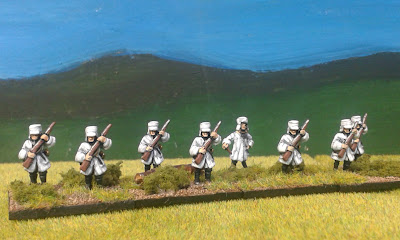A couple of days ago Paul from the
Man Cave posted a review of One Hour Wargames by Neil Thomas. He makes quite a few valid points, saying that the rules are really aimed at beginners and if you have any of the Charles Grant scenario books (which I do) then even the scenario section is largely superfluous. I think at face value there is a lot to agree with in this analysis. But I also think there are some other points that I would like to add to the review for a bit of balance.
![]() |
| The tome on trial |
First point - the rules are for beginners. Yes, they will work well for beginners to wargaming, but that doesn't describe me and I like them. It also doesn't include people like
Bob Cordery who has also taken them to heart. So what do we (Royal or collective 'we' as I can't necessarily speak for others) like about them? Well one of the selling points is the very simplicity that makes them so good for beginners. They are uncluttered, easy to remember and give a very enjoyable game. They are also a system that is easy to tinker with. Some might be put off by this, demanding a ruleset that suits them straight out of the box, as it were. Well these do play straight out of the box for the periods they cover, but they are so much more versatile than that. On the AMW yahoo group variants can be found that cover the Italian Wars, Spanish Civil War, Russo-Turkish War and more.
Martin Rapier recently published his latest variant that he is using for Jutland among others. There are a lot of experienced wargamers out there doing things with these rules.
Second point - What are you looking for in a set of rules? For me they need to be able to be used solo; to allow me to concentrate on the game and not the rules mechanisms; and to be relatively quick so that they can be played out between my children's bedtimes and my own. They should ideally be able to be turned into a narrative campaign. I also like rules that I can play on a small space in the lounge during winter - I have a 3'x 3' card table that I can set up, as opposed to the 8'x 4'which is in the garage. One Hour Wargames ticks all of the above boxes.
Third point - the scenarios. If you have the Grant books then you do indeed have a fantastic reservoir of ideas for scenarios (and I would add the Tabletop Teasers that ran through the Battlegames magazine to the other books named by Paul). But they still take some adaptation to whatever period you are playing. The scenarios in One Hour Wargames are designed to work with the rules and army sizes that are given, and they really do work. Even unbalanced scenarios have well thought out objectives and turn limits. Either Mr Thomas is very good at fluking it, or he put quite a bit of time into designing the rules and scenarios to work together.
My tinkering with the Great Northern Wars variant is based on bits of the horse and musket and the pike and shot rules together with some of my own little quirks (I like base removal to show the deterioration of unit effectiveness for instance). There has been ample room to introduce these things and not totally unbalance the system, nor over-complicate it - I print the rules out on a double sided sheet of A4 in a booklet format. Originally I had planned to fight a GNW campaign using an adaptation of Neil's Napoleonic Wargaming rules. I now wouldn't go back.
So in terms of this being a review, I guess I'd give One Hour Wargames 5 stars out of 5, because it works for the sort of games I want to play. Just like DBA is not for everyone, OHW will not be a perfect fit for all wargamers (what rules are?), but I must emphasise that they are not just for beginners. For myself, I feel like I may have found my holy grail.
Nate

























































































































































